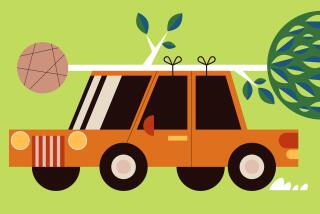Cutting Back on Pruning Errors : To Keep a Tree Healthy, Consider Its Structure Before Trimming
- Share via
If there’s one thing arborists would like to teach homeowners about trees, it’s this: Remember that they are living, breathing things, not inanimate objects.
You wouldn’t stand by while a friend went under the knife of an uneducated doctor, would you? But that’s what happens every day in Orange County yards, says Alden Kelley, a Fullerton-based consulting arborist.
Unfortunately, many homeowners prune trees or have them pruned in a way that injures them, says Kelley, who often gets distress calls from people who have had a pruning mishap.
“Because of a lack of education, many trees are topped, which refers to the removal of major portions of a tree without regard to the tree structure or form,” he says.
When a tree is pruned properly, it shouldn’t be obvious. “If it’s apparent that a tree has been pruned, then there is something wrong,” Kelley says. “Stubs, bare spots and a lot of defoliation indicate improper pruning.”
Although the typical response to an over-pruned tree is “it will grow back,” that’s not always possible, Kelley says. Severe topping sometimes kills trees or reduces their life spans. In all cases, topped trees are weakened and, ironically, begin growing more rapidly to make up for lost foliage, often leaving the homeowner with a bigger problem than existed before the pruning.
Over-pruned trees also often have structural problems and may grow back in an abnormal, unnatural fashion. Even with restorative pruning after a botched “operation,” it can take a tree many years to reach its former stature and form, Kelley says.
Prune a tree properly, however, and you’ll be rewarded with a well-formed, healthy tree that is strong and sturdy against destructive high winds and may need very little pruning. Well-pruned trees in good condition add to the value of a property; carelessly topped or chopped ones will decrease property value--dramatically in some cases, Kelley says.
Six years ago the city of Irvine started pruning all of its trees according to standards set by the International Society of Arboriculture. As a result, the trees now need pruning much less often, says Clay Martin, urban forester for the city. Irvine’s trees are now also healthier and stronger, which, Martin says, has resulted in a substantial reduction in storm damage.
Whether you’ll be pruning your trees or will hire help, it’s important to become educated about what constitutes proper pruning, Martin says. “The first thing to understand is that you or a tree trimmer should never make stub or topping cuts,” he says, referring to cutting a branch back arbitrarily to a set length with no regard to the structure of the tree.
To prune correctly, you must study the tree structure. Your ultimate goal is a balanced tree that has well-spaced, strong branches all the way up. Before you shorten a branch, make certain that there is another branch in that same area capable of taking over the lead role for the branch you are removing. For instance, if one part of a branch is rubbing against the house or about to touch a power line, look for a fairly mature side branch on that same limb that is growing in a more suitable direction.
Leaving an adequate secondary branch is critical, because it will take over the important function of controlling growth in that area of the tree. Without an existing branch of sufficient size to take over, the tree will weaken and grow many small, spindly twigs in the pruned area. This may make the tree appear out of balance, and these twigs are likely to break off during strong winds, says Orange certified arborist Jim Barry, who teaches arboriculture and landscape pruning practices at Fullerton College.
It’s also important to never cut a branch off flush to the trunk. Pruning to the trunk can cause the bark to die and decay in that area. Instead, leave intact the branch collar, which is a small bump at the base of the branch that is wider at the bottom than the top.
“You don’t need to be a tree expert to prune correctly,” Barry says. “You don’t even need to know the name of the tree you’re pruning. What you must do is carefully look at the tree structure and do whatever you can to preserve and strengthen it.”
He suggests viewing the tree as a framework. When doing this, spot any crossing or rubbing branches, which should be eliminated. You will also want to cut out dead, dying or broken branches. In general, unless the tree is creating a dangerous situation, you should prune no more than one-fifth to one-third of its foliage at any one pruning.
Many people prune trees to control size. Use caution when reducing the height of a tree, advises Barry, who notes that over-pruning to control height will only lead to more vigorous upward growth. Always make sure to leave secondary branches to take over.
Tree height maintenance is best done just before the tree is reaching the maximum allowable height, not after it is causing problems. Frequently in Orange County, to keep a tree under a certain height, it must be lightly pruned twice a year.
Reducing the height of a tree and correcting pruning mistakes will take some time, says Barry, who has restored many trees that have been topped. “It takes several years to re-establish the structure of the tree,” he says.
Safety when pruning is important, experts say. Prune with both feet on the ground. Unless you’ve been trained and have the proper equipment, you shouldn’t be climbing in your tree. Instead, hire a professional who prunes according to International Society of Arboriculture standards.
If you have a new tree, keep in mind that the training you give it in the first five years will affect the structure for life. Prune a tree right initially, and you won’t need to do much trimming when it gets older.
A good way to avoid pruning is to plant trees that need very little maintenance, such as the bottletree (Brachychiton populneus), which has a green trunk and leaves, Australian willow (Geijera parviflora) and many pines.
You can also save yourself the expense and work of pruning by considering your size limitations and choosing small trees and shrubs suitable for close quarters.
“People buy a tree in a five-gallon container and expect it to always be small, but trees are like kittens: They grow and start chewing on things,” says professional tree trimmer Joaquin Arias of Santa Ana.
Often, “Homeowners will plant many trees close to their house that are very large when mature, not realizing that there isn’t enough space for their root systems,” he says. “Some trees are doing so much damage to a property that the only choice is to remove them.”
There are many varieties of small trees. One of Arias’ favorites is the crape myrtle, which he says usually reaches 10 to 15 feet and not more than 25 feet in Orange County. This deciduous tree has pretty spring blossoms in pink, purple or white.
Arias also suggests planting shrubs that stay under 15 feet tall. Some of his suggestions include the Australian tea tree (Leptospermum laevigatum), which blossoms in late winter and spring in white, pink or purple, and India hawthorn (Rhaphiolepis indica), a slow-growing bush that has pink and white flowers.
Japanese black pines, which can be kept to 15 to 20 feet, are also a good small-tree choice, as are dwarf fruit tree varieties such as peach, which have very striking blossoms in the spring.
Other good small-tree choices suggested by consulting arborist Kelley include bronze loquat (Eriobotrya deflexa), coral gum (Eucalyptus torquata), gold medallion tree (Cassia leptophylla), lemon bottlebrush (Callistemon citrinus), little gem magnolia, Mediterranean fan palm (Chamaerops humilis), pineapple guava (Feijoa sellowiana), victoria magnolia, Western red bud (Cercis occidentalis) and willow pittosporum (Pittosporum phillyraeoides).






